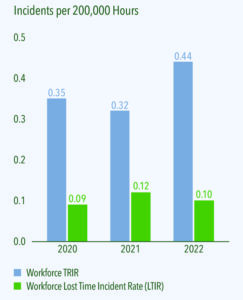Environment, Safety & Governance
Hess highlights progress in 2022 Sustainability Report

After outperforming its five-year emissions targets in 2020, Hess is now working toward new five-year reduction targets for 2025. This includes reducing its operated Scope 1 and 2 GHG emissions intensity to 17 kg per boe and its methane emissions intensity to 0.19%, as well as achieving zero routine flaring on operated assets.
Another milestone in 2022 was the signing of a forest preservation agreement with the government of Guyana, under which Hess will purchase REDD+ carbon credits for at least $750 million between 2022 and 2032.
In terms of workforce safety, Hess reported an increase in occupational safety incidents and releases in its Bakken operations in 2022. To address this, the operator implemented the Heavy Equipment Movement Procedure in the Bakken and began delivering third-party leadership training to Hess’ worksite supervisors at workover operations to further reinforce worksite accountability.
ADNOC brings net-zero goal forward by 5 years to 2045
ADNOC is accelerating its decarbonization plan and moving its net-zero ambition to 2045 from its previous target of 2050, and to achieve zero methane emissions by 2030. The plan is backed by an initial $15 billion allocation to low-carbon solutions.
In 2022, ADNOC’s upstream carbon intensity performance was approximately 7 kgCO2e/BOE and its methane intensity was approximately 0.07%.
Additionally, in 2022 ADNOC achieved greenhouse gas (GHG) emissions reductions of approximately 4 million tonnes by using grid energy from solar and nuclear power to supply 100% of its onshore operations, as well as approximately 1 million tonnes from energy efficiency and flaring reduction projects.
Further, ADNOC started two pilot projects this year to capture and permanently store CO2 as part of its plan to expand its carbon capture capacity to 5 million tonnes per year by 2023.
Separately, ADNOC recently signed an agreement with Occidental to evaluate CCS hub opportunities in the UAE and US, with a view to develop a carbon management platform. The agreement is enabled by the UAE-US Partnership for Accelerating Clean Energy, which is expected to catalyze $100 billion in clean energy and carbon management projects by 2035.
51 UKCS platforms signed up to help gather data for offshore bird database
Energy consultancy Xodus has signed up 51 platforms to its not-for-profit Offshore Bird Portal (OBP) since it launched in January. Oil and gas operators from across the UK Continental Shelf (UKCS) have signed up to aid in the recording and safeguarding of offshore species that visit assets based in the North Sea.
Managed by Xodus, the OBP was established to improve the gathering of geographic and seasonal data relating to seabirds and migrants on offshore platforms and structures. The database will enhance scientific understanding and ecological awareness across the energy industry.
NSTA: Domestic gas supports UK’s net-zero goals
North Sea gas is significantly cleaner and supports the drive to net-zero greenhouse gas emissions far more than imports, according to analysis by the North Sea Transition Authority (NSTA).
The research shows that domestically produced gas is, on average, almost four times cleaner than importing gas in LNG form. The primary drivers for the difference are the processes of liquefaction, then transportation via shipping, and finally regasification.
The report shows that the UK produced 38% of its gas supply in 2022, but that gas was responsible for only 24% of the associated total emissions.
 Murphy pushes its water recycling ratio to record high
Murphy pushes its water recycling ratio to record high
Murphy Oil’s new Sustainability Report shows that, from 2019 to 2022, the company achieved reductions in its greenhouse gas (GHG) emissions, methane and flaring intensities by between 25-60% (see figure at right). It also surpassed last year’s water recycling record, increasing the percentage of recycled water to total water consumption from 17% in 2021 to 27% in 2022. Additionally, 31% of flowback and produced water in 2022 was recycled, up from 14% in 2021.
Due to higher levels of activity, Murphy’s total recordable incidence rate increased from 0.28 in 2021 to 0.37 in 2022, although its lost-time incidence rate improved from 0.04 to 0.03.




